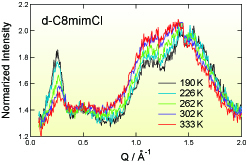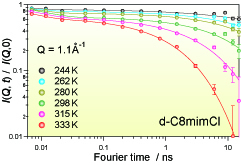Short- and Intermediate-range Structure and
Slow Dynamics of an Ionic Liquid C8mimCl
Yamamuro Group
Ionic liquids (ILs) are very interesting materials not only for various applications but also for basic science of liquids. Most of ILs have glass transitions at low temperatures and the related temperature dependence of viscosity is not understood by Stokes-Einstein scenario. This can be related to hierarchical structure and dynamics of ILs. Most of cations of ILs have core parts with positive charge and also have mostly neutral methyl-groups and longer alkyl-chains. Furthermore, it was recently found that ILs have separating ionic and neutral (alkyl-chain) domains of a nanometer scale. They may have different time scales of diffusive motions. The purpose of our study is to clarify the hierarchical structure and dynamics of ILs by using various neutron scattering techniques, i.e., neutron diffraction, quasi- and inelastic scattering, spin echo, etc. We have already investigated several imidazolium ILs with relatively shorter alkyl-chains and found that alkyl-chains are highly disordered and moving very fast (in ps order) at room temperature. In this work, we have taken fully-deuterated 1-octyl-3-methyimidazolium chloride (d-C8mimCl) which has relatively longer alkyl-chains and so may have clear domain structure. The deuteration was required to avoid strong incoherent scattering from hydrogen (H) atoms.

Fig. 1. Neutron diffraction patterns of d-C8mimCl ionic liquid measured as a function of temperature.

Fig. 2. Intermediate scattering function of d-C8mimCl ionic liquid measured by a neutron spin echo technique as a function of temperature.
Figure 1 shows the neutron diffraction patterns of d-C8mimCl measured by HERMES (IMR, Tohoku Univ.) installed at JRR-3, JAEA. The peaks around 0.3, 1.1, and 1.4 Å-1 are considered to be due to the correlations of domains, ions, and alkyl-chains, respectively. As cooling the sample, the inter-ionic and inter alkyl peaks shifted to the high-Q side, indicating compact packing of local structure, while the inter-domain peak was grown and shifted to the low-Q side, indicating clear contrast and expansion of domains. The diffraction pattern was not changed much around 190 K because of the freezing phenomenon (glass transition) around 200 K. This is the first neutron diffraction data demonstrating clear temperature dependence of IL domains. Figure 2 shows the intermediate scattering function of d-C8mimCl obtained by a neutron spin-echo (NSE) instrument installed at National Institute of Standard and Technology (NIST), USA. There were fast and slow relaxations depending on temperature. These curves were fitted well with the combination of an exponential and a stretched exponential functions as shown in Fig. 2. The fast motion did not change much with temperature while the slow motion had Arrhenius temperature dependence with the activation energy of 36 kJ mol-1. The fast and slow motions may be related to the local motion of alkyl-chain and the diffusion of ions, respectively. The time-scale of domain motion was found to be slower than 10 ns from the NSE measurement at Q = 0.28 Å-1. This is also the first data showing the dynamics of ions and domains of ILs.
